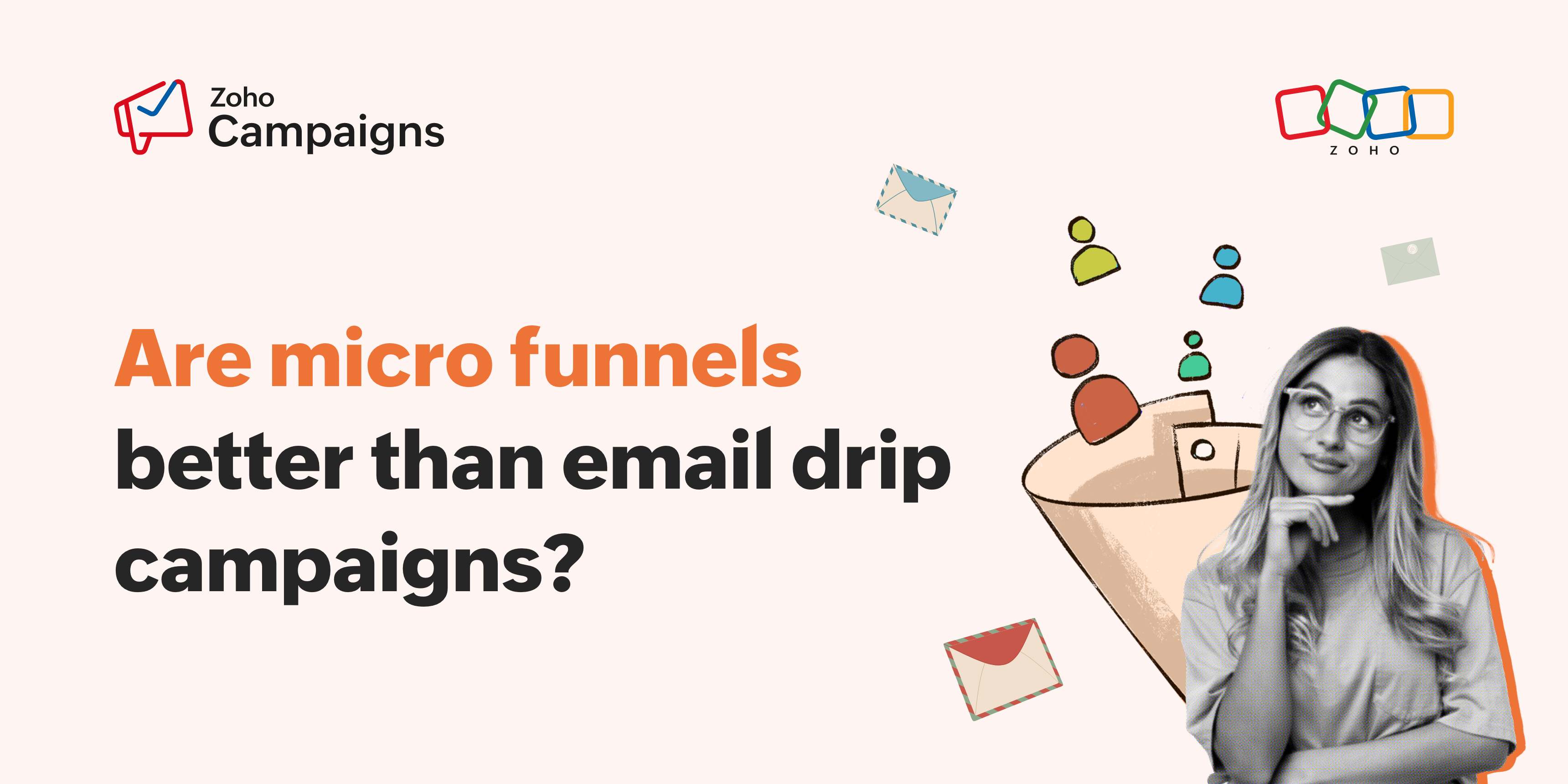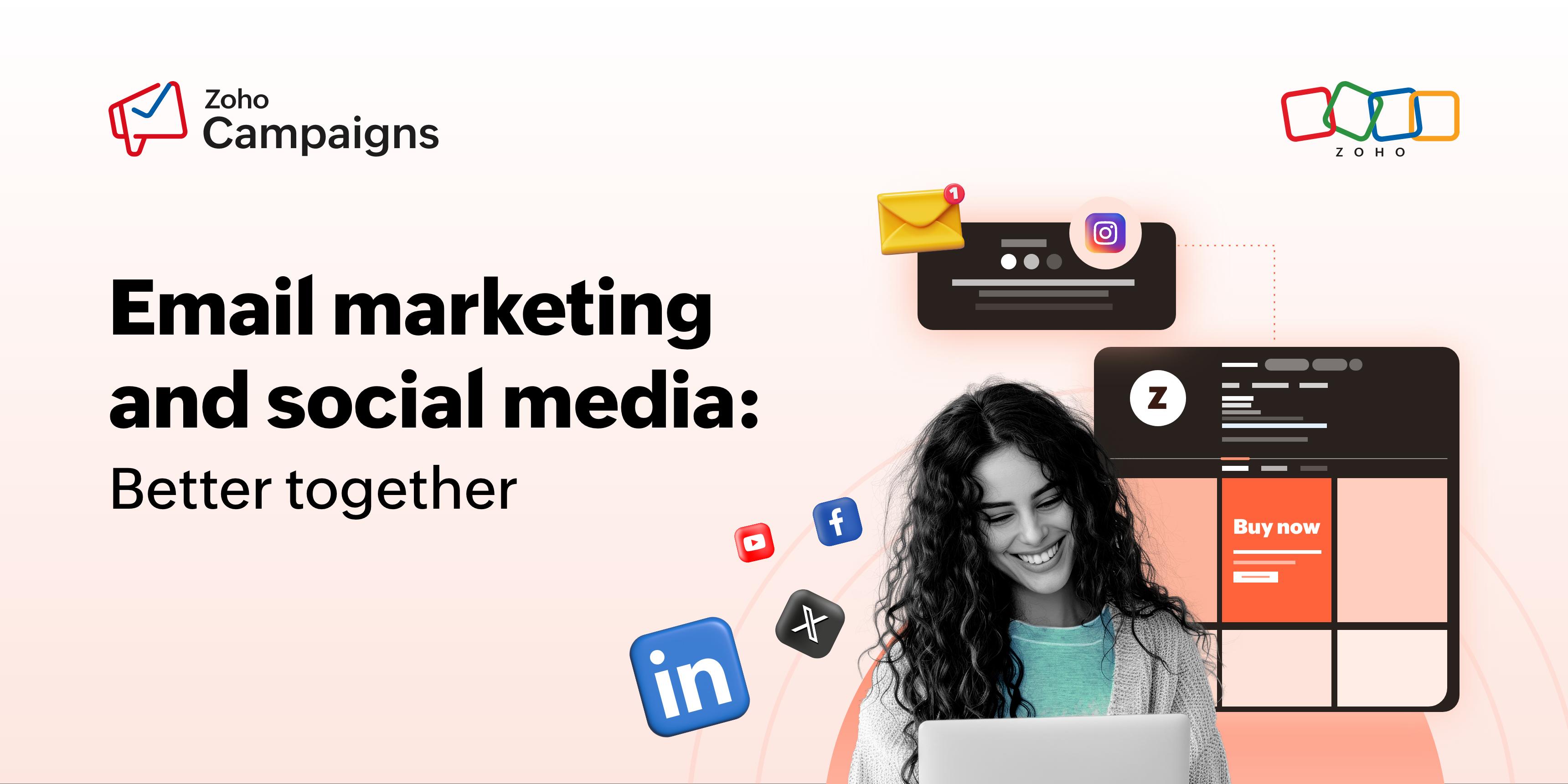- HOME
- Email Marketing
- Micro funnels vs Drip campaigns: Which email strategy is right for you?
Micro funnels vs Drip campaigns: Which email strategy is right for you?
- Last Updated : August 26, 2024
- 187 Views
- 6 Min Read

If you're in sales or marketing, talking about funnels, strategizing, and targeting is basically second nature to you—like breathing. But here's the thing: Traditional marketing funnels can sometimes be too broad, often missing the mark with generalized content that doesn't really hit home for individual customer needs. That's where micro funnels come in. Simply put, micro funnels take the broad customer journey and break it down into smaller, more manageable steps, each one tailored to what your customer needs at that exact moment.
Now, you might be thinking, "Isn't that what drip emails are all about?" Well, yes and no. On the surface, they might seem synonymous, but when you dig a little deeper, you'll see that these two marketing strategies solve different challenges. Drip emails are all about gradually guiding someone along a path, while micro funnels are like having multiple paths ready to go, each one customized for where the customer is on their journey.
Both are designed to engage, nurture, and convert, but they approach it in different ways. So, how do you decide which one is right for your business? Let's start with the basics.
What are micro funnels?
Micro funnels are simply hyper-focused segments within the broader marketing funnel. Instead of taking your customers on a generic, one-size-fits-all journey, micro funnels break down the journey into smaller, bite-sized steps. Each step is tailored to what your customer needs right then and there—like a personal shopping assistant guiding them along.
For example, instead of herding all your customers through the same funnel, you might use micro funnels to zoom in on those who have shown interest in a particular product, those who bailed during checkout (we've all been there!), or even those loyal customers who keep coming back for more and might even be ready for an upsell.
How do micro funnels work?
It's all about segmentation. Whether it's their behavior, demographics, or where they are in the buying process, you deliver content that feels like it was made just for them. This could be anything from nurturing a lead to make a purchase, re-engaging lapsed customers, or encouraging repeat business.
Here's what a typical micro funnel flow looks like:
1. Identify customer segment
↓
2. Trigger action (e.g., product interest, cart abandonment)
↓
3. Send targeted content
↓
4. Customer takes specific action
↓
5. Move to next micro funnel or conversion
Now, let's put this micro funnel into action in a real-life scenario: Imagine you're an ecommerce retailer with a customer who frequently buys workout gear. Instead of treating them like every other customer, you could create a precision-targeted micro funnel just for them. Start by sending them personalized content showcasing the newest fitness products, exclusive offers tailored to their interests, and helpful fitness tips. This focused approach keeps them engaged, and before you know it, they're adding more items to their cart and making another purchase.
What are email drip campaigns?
Drip campaigns, on the other hand, are series of pre-scheduled emails that are sent out over time. The idea is to "drip" information or content to your subscribers gradually to nurture leads, keep your audience engaged, or guide them toward specific actions.
Drip campaigns are your go-to for welcome sequences, onboarding new users, or staying top-of-mind with leads long-term. For instance, after someone signs up for your newsletter, you might have a drip campaign that sends them a welcome email, followed by a series of emails introducing your brand, sharing customer stories, and eventually offering a discount code.
How do drip campaigns work?
Drip campaigns operate on triggers—events or actions that start the flow of emails. These triggers could be anything from a new subscriber joining your list, a customer making a purchase, or a user abandoning their cart. Once the trigger is activated, the campaign begins sending emails at pre-determined intervals.
Drip campaign flow:
1. Sign up/trigger event (e.g., newsletter signup, purchase)
↓
2. Send welcome email (Day 1)
↓
3. Send follow-up content (Day 3)
↓
4. Send additional content/offer (Day 7)
↓
5. Send final push/reminder (Day 14)
↓
6. Monitor engagement/conversion
↓
7. End campaign or continue engagement
Key differences between micro funnels and drip campaigns
Scope and focus
- Micro funnels: Laser-focused on specific goals, like converting leads or upselling products.
- Drip campaigns: More like a gentle, ongoing conversation that keeps your brand top of mind. Perfect for playing the long game.
Personalization and engagement
- Micro funnels: These are the kings of personalization, delivering content that hits home for specific segments.
- Drip campaigns: While they can be personalized, they tend to be broader, keeping the conversation going without getting too deep.
Flexibility and adaptability
- Micro funnels: Highly adaptable; they change and evolve with your customers.
- Drip campaigns: More set in their ways, drip campaigns are perfect for steady, consistent messaging, but might not react quickly to sudden shifts.
Complexity
- Micro funnels: These require a bit more elbow grease to set up and maintain, but the payoff in engagement is well worth it.
- Drip campaigns: Easier to set up and run on autopilot, making them great for when you're short on time or resources.

Choosing the right strategy for your business
When to use micro funnels
Micro funnels work best for precision marketing. They're your go-to if:
You have a large, diverse audience: Micro funnels let you tailor your messaging to different segments, so everyone feels like you're speaking directly to them.
You're selling complex or high-ticket products: Micro funnels can guide your customers through the decision-making process step by step.
You want to maximize customer lifetime value: Use micro funnels to upsell and cross-sell to existing customers and squeeze more value out of each relationship.
When to use drip campaigns
Drip campaigns are ideal for building relationships over time and keeping your brand in the spotlight. They're your best bet if:
You're onboarding new customers or subscribers: Drip campaigns can slowly introduce new users to your product or service to help them get comfortable.
You want to maintain long-term engagement: Drip campaigns provide a steady stream of content that keeps your brand top of mind.
You're running a promotion: Drip campaigns are effective for rolling out a promotion over time. By gradually releasing information, special offers, or reminders, you can build anticipation, maintain momentum, and keep your audience engaged throughout the duration of the promotion.
Best of both worlds: Combining micro funnels and drip campaigns
The good news is you don't have to choose between micro funnels and drip campaigns—they can complement each other beautifully. Here's how.
Start with a drip campaign, then segment into micro funnels
Begin with a broad drip campaign to engage your audience and build a relationship. As you gather more data on their behavior, segment them into micro funnels for more targeted messaging.
A fashion retailer could start with a drip campaign for all new subscribers that includes a welcome series with brand information and popular product highlights. Once they identify which subscribers are interested in specific categories (e.g., men's clothing vs. women's clothing), they can move them into micro funnels that focus on those specific interests.
Use micro funnels to re-engage drip campaign contacts
If your drip campaign contacts start to lose interest or disengage, use micro funnels to target them with more specific offers or content to reignite their interest.
A software company could use a micro funnel to re-engage users who have stopped using their product by offering them personalized content or a special discount.
Enhance drip campaigns with micro funnel insights
Use the insights gained from micro funnels to refine and enhance your drip campaigns, ensuring that each touchpoint is as relevant and effective as possible.
An online retailer could analyze which micro funnel segments perform best in terms of conversions and then apply those learnings to tweak the messaging or offers in their broader drip campaigns.
The final choice
Both micro funnels and drip campaigns have their strengths, and the right choice for your business depends on your goals, resources, and audience. Micro funnels offer pinpoint precision and are perfect for targeted, high-impact campaigns, while drip campaigns are masters of long-term engagement and nurturing leads over time.
For many businesses, the sweet spot might be a combination of both—using drip campaigns to build and maintain relationships, and micro funnels to deliver the right message to the right person at the right time.
So, which will it be? Micro funnels, drip campaigns, or a mix of both? The choice is yours, and with the right strategy, the results can be spectacular.
Ready to see the magic in action? Try Zoho Campaigns and create your first micro funnel or drip campaign today. Whether you're looking to engage, nurture, or convert, Zoho Campaigns gives you the tools you need to succeed.












